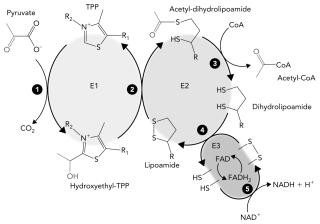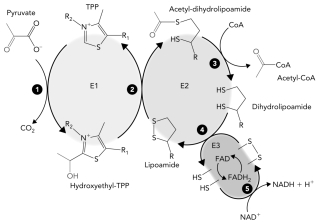A) cholesterol synthesis
B) heme synthesis
C) gluconeogenesis
D) amino acid synthesis
F) None of the above
Correct Answer

verified
Correct Answer
verified
Multiple Choice
A high concentration of which molecule would inhibit citrate synthase in the citrate cycle?
A) AMP
B) ADP
C) NAD+
D) ATP
F) None of the above
Correct Answer

verified
Correct Answer
verified
Multiple Choice
When the citrate cycle is inhibited,which two metabolites are exported to the cytosol for fatty acid and cholesterol synthesis?
A) malate and succinyl-CoA
B) succinyl-CoA and ![]() -ketoglutarate
-ketoglutarate
C) ![]() -ketoglutarate and citrate
-ketoglutarate and citrate
D) citrate and malate
F) All of the above
Correct Answer

verified
Correct Answer
verified
Multiple Choice
Classify the reaction that occurs at step 5 in the reaction schematic of the pyruvate dehydrogenase reaction below. 
A) isomerization
B) addition
C) oxidation reduction
D) decarboxylation
F) None of the above
Correct Answer

verified
Correct Answer
verified
Essay
Predict the fate of acetyl-CoA and oxaloacetate when the citrate cycle is inhibited.
Correct Answer

verified
Acetyl Co-A is used in the cytosol for c...View Answer
Show Answer
Correct Answer
verified
View Answer
Multiple Choice
A high NADH to NAD+ ratio would inhibit which enzyme in the citrate cycle?
A) succinate dehydrogenase
B) succinyl-CoA synthetase
C) aconitase
D) isocitrate dehydrogenase
F) None of the above
Correct Answer

verified
Correct Answer
verified
Multiple Choice
High levels of ATP would result in the inhibition of which enzyme in the citrate cycle?
A) succinate dehydrogenase
B) isocitrate dehydrogenase
C) malate dehydrogenase
D) fumarase
F) A) and B)
Correct Answer

verified
Correct Answer
verified
Multiple Choice
A low NADH to NAD+ ratio would activate which enzyme in the citrate cycle?
A) succinyl-CoA synthetase
B) fumarase
C) citrate synthase
D) succinate dehydrogenase
F) B) and D)
Correct Answer

verified
Correct Answer
verified
Multiple Choice
Which coenzyme in the citrate cycle is affected by arsenic?
A) coenzyme A
B) thiamine pyrophosphate
C) dihydrolipopyl acetyltransferase
D) flavin adenine dinucleotide
F) B) and C)
Correct Answer

verified
Correct Answer
verified
Multiple Choice
Classify the reaction that occurs at step 4 in the reaction schematic of the pyruvate dehydrogenase reaction below. 
A) isomerization
B) addition
C) oxidation reduction
D) decarboxylation
F) C) and D)
Correct Answer

verified
Correct Answer
verified
Multiple Choice
Which enzyme requires CoASH to produce acetyl-CoA?
A) pyruvate dehydrogenase
B) citrate synthase
C) isocitrate dehydrogenase
D) ![]() -ketoglutarate dehydrogenase
-ketoglutarate dehydrogenase
F) A) and D)
Correct Answer

verified
Correct Answer
verified
Essay
The  of the conversion from malate to oxaloacetate in the last reaction of the citrate cycle is very large,indicating this reaction is not thermodynamically favorable.Propose an explanation for how this reaction can proceed in the forward direction despite the very positive
of the conversion from malate to oxaloacetate in the last reaction of the citrate cycle is very large,indicating this reaction is not thermodynamically favorable.Propose an explanation for how this reaction can proceed in the forward direction despite the very positive  value.
value.
Correct Answer

verified
The oxaloacetate concentrations are kept...View Answer
Show Answer
Correct Answer
verified
View Answer
Essay
Describe the fate of NADH and FADH2 produced in the citrate cycle.
Correct Answer

verified
NADH and FADH2 enter the electr...View Answer
Show Answer
Correct Answer
verified
View Answer
Essay
Corn-rich diets in Europe in the 1700s resulted in the disease pellagra.Though Mexico also had a corn-rich diet at the time,this disease was rare there.Propose a reason for this observation.
Correct Answer

verified
Pellagra is the result of a niacin defic...View Answer
Show Answer
Correct Answer
verified
View Answer
Multiple Choice
The reaction catalyzed by __________ is likely to be reversible under cellular conditions according to the  .
.
A) malate dehydrogenase
B) citrate synthase
C) succinate dehydrogenase
D) ![]() -ketoglutarate dehydrogenase
-ketoglutarate dehydrogenase
F) None of the above
Correct Answer

verified
Correct Answer
verified
Multiple Choice
The disease beriberi is a result of which vitamin deficiency?
A) thiamine
B) pantothenic acid
C) riboflavin
D) niacin
F) A) and C)
Correct Answer

verified
Correct Answer
verified
Multiple Choice
How would an increased level of acetyl-CoA be expected to affect the pyruvate dehydrogenase reaction?
A) The pyruvate dehydrogenase kinase enzyme activity would increase, resulting in an inhibition of pyruvate dehydrogenase activity.
B) The last step of the pyruvate dehydrogenase reaction would be blocked, resulting in a decrease in activity.
C) The E1 subunit would be phosphorylated by pyruvate dehydrogenase kinase, and the catalytic activity of pyruvate dehydrogenase would decrease.
D) The pyruvate dehydrogenase phosphatase-1 enzyme would increase, resulting in pyruvate dehydrogenase activation at an accelerated rate.
F) A) and B)
Correct Answer

verified
Correct Answer
verified
Multiple Choice
How is the pyruvate dehydrogenase reaction regulated?
A) pH and enzyme conformation
B) pH and the protonation state of the active site
C) allosteric control and covalent modification
D) product inhibition
F) A) and D)
Correct Answer

verified
Correct Answer
verified
Essay
Use the overall net reaction of the citrate cycle to explain why excess NADH inhibits the pyruvate dehydrogenase reaction.
Correct Answer

verified
NADH is a product in the balanced citrat...View Answer
Show Answer
Correct Answer
verified
View Answer
Multiple Choice
Regeneration of NAD+ and FAD inside the mitochondrial matrix is required because
A) anabolic reactions generally require them.
B) they produce GDP through the citrate cycle.
C) they transport pyruvate through the matrix.
D) they maintain flux through the citrate cycle.
F) A) and B)
Correct Answer

verified
Correct Answer
verified
Showing 21 - 40 of 100
Related Exams